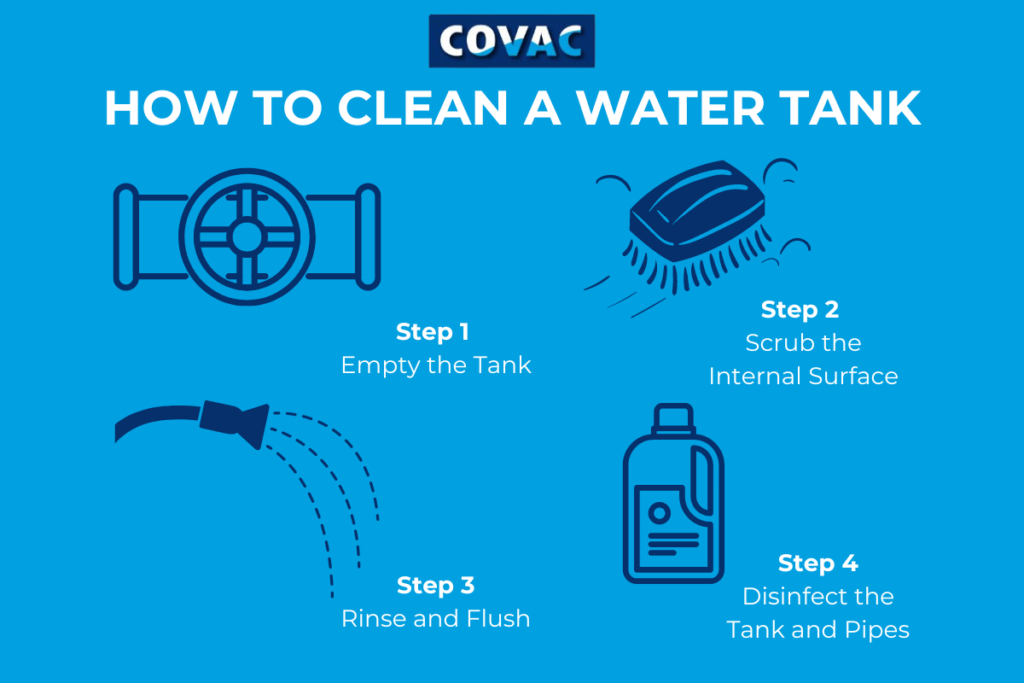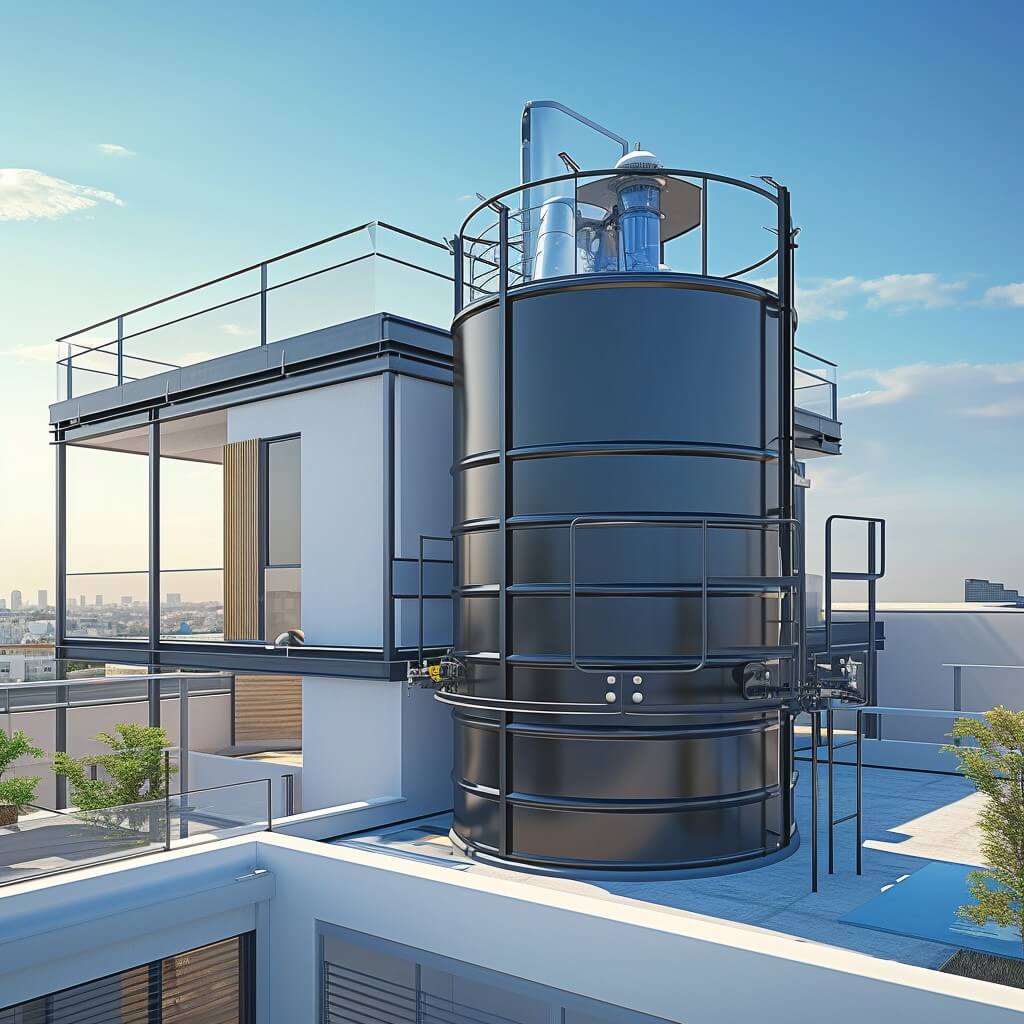
Comprehensive Guide to Water Tank Cleaning
Ensuring your water tank is clean is essential for maintaining safe and healthy water for your household.
Many homeowners have questions about how to effectively clean their water tanks, how often it should be done, and what materials or methods are best.
This guide aims to address these common concerns with practical advice and relatable examples, making the process of water tank cleaning straightforward and manageable.

Common Questions and Concerns
- Why is water tank cleaning important?
- How often should I clean my water tank?
- What are the steps involved in cleaning a water tank?
- What materials do I need for cleaning?
- Are there any safety precautions I should take?
Why Water Tank Cleaning is Important
Keeping your water tank clean ensures that the water you use for drinking, cooking, and bathing is free from contaminants.
Over time, sediment, algae, and bacteria can build up in your tank, potentially causing health issues.
Regular cleaning helps prevent these problems, ensuring your water remains safe and clean.
Example:
Think about the last time you noticed sediment at the bottom of a glass of water.
Imagine that on a much larger scale inside your water tank.
Regular cleaning prevents this sediment from affecting your water quality.
Unclean water tanks can harbor a variety of harmful pathogens, including bacteria, viruses, and parasites.
These microorganisms can lead to waterborne diseases, which can be especially dangerous for young children, the elderly, and individuals with weakened immune systems.
By maintaining a clean water tank, you are safeguarding your family’s health and well-being.
Relatable Story:
I remember the first time we noticed a funny taste in our water. It turned out our tank hadn’t been cleaned in two years.
After a thorough cleaning, the water tasted fresh and clean again.
Now, we make it a point to clean it every spring.
How Often Should You Clean Your Water Tank?
Most experts recommend cleaning your water tank at least once a year.
However, if you live in an area with high sediment levels in the water or notice changes in water quality (like an unusual taste or color), you might need to clean it more frequently.
Factors to Consider:
- Water Quality: If your water source is prone to contamination or has high mineral content, you may need to clean your tank more often.
- Climate: In warmer climates, algae and bacteria can grow more rapidly, necessitating more frequent cleaning.
- Usage: High usage can lead to faster accumulation of sediment and debris, requiring more regular cleaning.
Personal Story: Our neighbourhood experienced a sudden change in water quality due to nearby construction work.
The water turned murky, and we knew it was time to clean the tank even though it had only been six months since the last cleaning.
Staying vigilant about water quality can help you decide when it’s time for a clean.
Steps for Cleaning Your Water Tank
Cleaning your water tank might seem like a daunting task, but breaking it down into manageable steps makes it much easier.
Here’s a detailed, step-by-step guide to help you through the process:
Step 1: Drain the Tank
Start by emptying the tank completely. This might involve using a pump or manually draining it into buckets.
Make sure to turn off the water supply to prevent any more water from entering the tank while you clean.
Tip: If possible, use the water for gardening or other non-drinking purposes to avoid wasting it.
Step 2: Scrub the Interior
Use a long-handled brush and a mild cleaning solution (like a mix of water and bleach) to scrub the inside walls of the tank.
Make sure to reach all corners and crevices.
This step helps remove any algae, sediment, and biofilm that have accumulated on the tank walls.
Detailed Cleaning: Focus on areas where sediment tends to accumulate, such as the bottom and around any internal fittings. A thorough scrub ensures that all potential contaminants are removed.
Pro Tip: For stubborn stains, a paste made of baking soda and water can be effective. Apply it to the stains, let it sit for a few minutes, then scrub away.

Step 3: Rinse Thoroughly
Rinse the tank several times with clean water to remove any cleaning solution residue.
It’s crucial to ensure all traces of bleach or other cleaning agents are washed away, as these can contaminate your water supply.
Technique: Fill the tank partially with clean water, then use a hose to spray down the sides and bottom, ensuring all areas are thoroughly rinsed.
Step 4: Disinfect
Fill the tank with a solution of water and household bleach (about one tablespoon of bleach per gallon of water).
Let it sit for a few hours to kill any remaining bacteria or algae.
Safety Note: Make sure to keep the tank sealed during this process to avoid any contamination from external sources.
Step 5: Final Rinse
Drain the bleach solution and rinse the tank thoroughly with clean water.
Ensure that all the bleach has been flushed out to prevent any residual taste or odour in your water supply.
Thorough Rinse: It’s recommended to rinse the tank multiple times to ensure all disinfectant is removed.
Materials Needed for Cleaning
- A long-handled brush
- Mild cleaning solution (water and bleach)
- Buckets or a water pump
- Gloves and safety goggles
- Hose for rinsing
- Baking soda (for stubborn stains)
Additional Tips for Maintaining Your Water Tank
Regular Inspections
Regularly inspect your water tank for any signs of damage or contamination. Look for cracks, leaks, or rust that might compromise the integrity of the tank.
Early detection of these issues can prevent more significant problems down the line.
Use a Filter
Installing a filter at the inlet of your water tank can help reduce the amount of sediment and debris that enters the tank.
This can significantly decrease the frequency of cleaning needed and improve the overall quality of your water.
Pro Tip: Regularly clean or replace the filter to ensure it remains effective.
Keep the Area Around the Tank Clean
Ensure the area around your water tank is clean and free of debris.
This helps prevent contaminants from entering the tank when it’s being filled or during maintenance.
Troubleshooting Common Problems
Unpleasant Odors
If you notice a foul smell coming from your water tank, it could be due to the buildup of organic matter or bacteria.
A thorough cleaning and disinfection should resolve this issue.
Regular maintenance can prevent odours from developing in the first place.
Discoloured Water
Discoloured water often indicates the presence of rust, sediment, or algae.
Flushing the tank and using a water filter can help clear up the water. If the problem persists, consider having your water source tested for contaminants.
Relatable Example: Once, our water started coming out with a slight brown tint. It turned out to be sediment buildup. After a good cleaning and installing a new filter, the water was crystal clear again.
The Environmental Impact of Water Tank Cleaning
Being mindful of the environment when cleaning your water tank is essential.
Use eco-friendly cleaning solutions whenever possible and avoid excessive use of chemicals.
Additionally, consider how you dispose of the wastewater from your tank.
Using it for non-potable purposes like irrigation can help reduce waste.
Conclusion
Ensuring your water tank is clean is not just a task but an essential part of maintaining a healthy and safe home environment.
Regular cleaning prevents the buildup of harmful bacteria, algae, and sediment, safeguarding your family’s water supply.
By following the detailed steps provided in this guide, you can approach this necessary chore with confidence and efficiency.
Remember, the frequency of cleaning may vary based on your water quality, climate, and usage.
However, committing to an annual clean and staying vigilant about any changes in your water can help maintain optimal water quality.
Use eco-friendly cleaning solutions whenever possible, and always prioritise safety by wearing protective gear and ensuring proper ventilation.
Your journey towards maintaining a clean water tank is a proactive step in ensuring the well-being of your household.
By keeping your tank in top condition, you are investing in your family’s health and peace of mind.
We encourage you to share your experiences, ask questions, and engage with our community. Together, we can ensure that everyone has access to clean, safe water.
Thank you for taking the time to read this comprehensive guide. We hope it has been informative and helpful.
Happy cleaning!